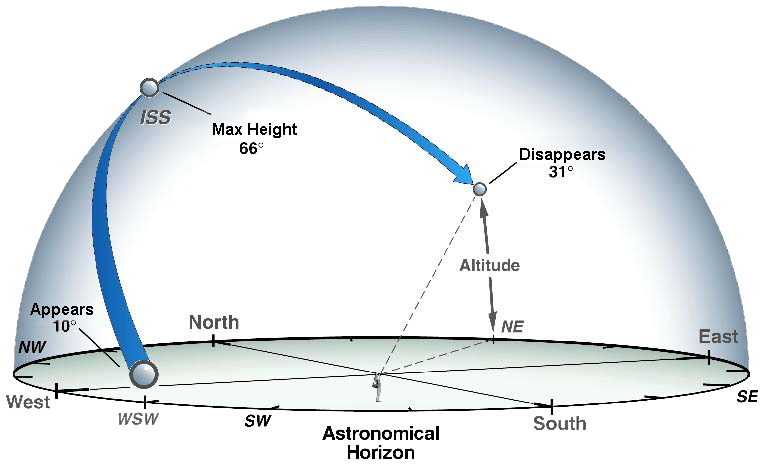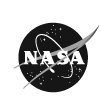Frequently Asked Questions
What does all this sighting information mean?
Time is when the sighting opportunity will begin in your local time zone. All sightings will occur within a few hours before or after sunrise or sunset. This is the optimum viewing period as the sun reflects off the space station and contrasts against the darker sky.
Visible is the maximum time period the space station is visible before crossing back below the horizon.
Max Height is measured in degrees (also known as elevation). It represents the height of the space station from the horizon in the night sky. The horizon is at zero degrees, and directly overhead is ninety degrees. If you hold your fist at arm's length and place your fist resting on the horizon, the top will be about 10 degrees.
Appears is the location in the sky where the station will be visible first. This value, like maximum height, also is measured in degrees from the horizon. The letters represent compass directions -- N is north, WNW is west by northwest, and so on.
Disappears represents where in the night sky the International Space Station will leave your field of view.

If you signed up, entered your registration code and received an on-screen confirmation message then you're signed up! Chances are the International Space Station just hasn't passed over your location at dawn or dusk yet. Read the FAQ “Why aren't there any sighting opportunities for my location” for more information.
If you signed up with your email address, check your spam folder to see if alert messages are going there. Add SpotTheStation@hq.nasa.gov to your list of allowed senders to prevent alerts from going to spam or junk email.
If you signed up by email make sure the email containing the code didn't end up in your spam folder. This email will appear to come from noreply@nasa.gov.
Add the SpotTheStation@hq.nasa.gov email address to your list of allowed senders.
If it has been more than one hour and you haven't received the requested code please try the process again and if you're still have problems, email us at SpotTheStation@hq.nasa.gov for assistance.
Alerts are generally sent about 24 hours before the International Space Station pass. This means you'll receive the message the night before for a morning pass and the morning of for an evening pass.
If you are not receiving the alerts on time, see related FAQs for an explanation.
Spot The Station alerts are sent out 24 hours before an upcoming space station pass. Unfortunately, some email providers queue messages in an unpredictable way. Adding SpotTheStation@hq.nasa.gov to list of allowed senders or contacts list might help.
You can also obtain a two-week schedule of space station passes from the website. Please see the next FAQ for details.
Visit the Sighting Opportunities page and enter your location to find out when the space station will be passing over you during the next two weeks.
You can bookmark this page or print the schedule for easy access.
"The email address / mobile number you entered is not valid” - Make sure you have entered a properly formatted email or SMS address. Mobile phone numbers do not require any formatting, you can simply enter as a string of digits; special characters like parenthesis and dashes are not required.
“The email address / mobile number you provided cannot be found” - You are attempting to renew or cancel alerts for an email address or mobile number that does not appear to be registered.
"It looks like you have already attempted this process but not yet completed it. Please check your email or text messages for an 8-digit code and instructions to complete the process or wait 24-hours and try again.” - You will receive this error message if you try to initiate the same request more than three times without entering your 8-digit code to complete the process. Please complete your request now or wait 24-hours and try again.
“The code you entered is not valid. Please try again.” - If you have received this message, verify the correct 8-digit code is entered and that the code is less than 24-hours old. Codes expire after 24-hours at which point a new code will be required.
"You must cancel your current alert before creating a new one or create a new alert using a different email address or mobile number.” - You can only sign up for one alert per email address or mobile number. If you want to change the alert you are receiving you have to cancel the existing alert and sign up for a new one. If you wish to have alerts sent to you for more than one location you can sign up using different email addresses or mobile numbers.
“You have already completed your sign up / renewal / cancellation” - You will receive this error message if you attempt to enter your 8-digit code more than once. No further action is required.
“You have exceeded the number of incomplete requests allowed from your IP address. Please wait 24-hours and try again.” - To prevent spam, Spot The Station limits the number of incomplete requests allowed from each IP address. Please complete your request now or wait 24-hours and try your request again
If you are receiving other error messages or continue to have trouble, please let us know.
Your SMS Address is an email address used to send text messages to mobile phones. The format is your 10-digit mobile number followed by the email address of your mobile carrier. For example, an AT&T SMS address would be 12345678910@text.att.net. Check with your individual carrier for their format.
Last Updated:

